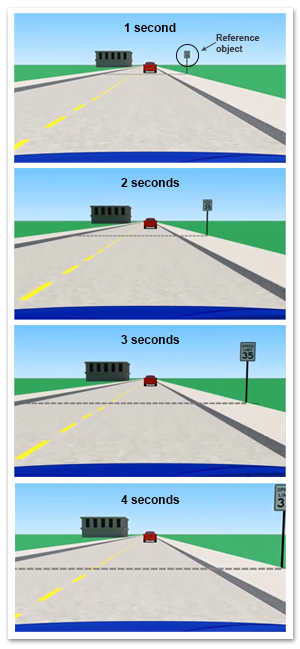Learning to drive is an exciting time in a teen’s life, but it can also be a dangerous time. Car crashes are a leading cause of death for 15- to 20-year-olds. In 2020, there were 1,885 young drivers who died in crashes, with an estimated 189,950 young drivers injured. There are several reasons teen drivers are at greater risk of collisions than more experienced drivers. Here are the five most common mistakes teen drivers make and how to avoid them.

1. Speeding
Speeding is one of the most common mistakes any driver makes. In 2020, drivers age 15-20 were speeding at the time of a fatal crash more than any other age group. Some teen drivers think speeding is no big deal. Others have a difficult time controlling their vehicle and forget to keep an eye on their speed.
Here are some ways teen drivers can avoid speeding:
- Keep track of your speed by glancing at the speedometer frequently and keeping with the flow of traffic.
- Slow down when approaching and crossing an intersection, going around a curve, approaching the top of a hill, or traveling on a narrow and winding road.
- Drive under the speed limit when conditions call for it (e.g., adverse weather, crowded roads, or limited vision).
- Give yourself plenty of time to get to your destination.
Speeding is never worth the risk.
2. Distracted Driving

Distracted driving is a big problem for drivers. There were 3,142 people killed in distracted driving-related collisions in 2020. Six percent of those killed were teens age 15 to 19.
Distracted driving is any non-driving activity that draws your attention away from the driving task. Common distractions include:
- Talking or texting on a wireless device
- Adjusting in-vehicle devices (e.g., navigation system, air-conditioning, heating, stereo)
- Looking over at your passengers
- Talking to your passengers or on a wireless device
- Dealing with strong emotions
Here are a few tips for teens to avoid distracted driving:
- Plan ahead for your drive. Program the GPS before you leave, and put your phone on "Do Not Disturb While Driving" mode if you can. This will silence notifications and can even send automatic replies to anyone who tries to contact you while you’re driving.
- Pull off the road in a safe place if you need to do anything that will take your attention off the driving task.
- Don’t look at passengers when you talk to them or talk with your hands. When you need to check the time, your speed, etc., give it a quick glance, then look at the road again.
Driving distracted puts everyone on the road at risk. Do everything you can to avoid driving distracted.
3. Drinking and Driving
Even though the legal drinking age is age 21, twenty-nine percent of young drivers killed in 2020 collisions had alcohol in their system at the time of collision.
Alcohol-impaired drivers are less likely to wear a seat belt. Sixty-two percent of the young drivers who had been drinking and died in collisions weren’t wearing a seat belt.
It’s never safe to drive when you’ve been drinking or using other drugs. Here are some alternatives to impaired driving:
- Designate a sober driver who won’t drink or use other drugs that day so they can safely drive everyone home.
- Call a cab or a rideshare service, or a trusted friend or family member to pick you up.
- If you’re at a party, consider sleeping over rather than driving home at night when you’re impaired.
- Decide not to drink or use other drugs, especially if you’re not sure how you’ll get home.
Of course, it’s safest for teens to avoid alcohol and other drugs altogether.
Stay safe by planning ahead when you know you’re going use alcohol or other drugs to make sure you’re not forced to decide whether or not to drive while your judgment is impaired. If you’re going out with friends, make sure ahead of time that you’ll all be able to get home safely. Never get in the car with a driver who’s intoxicated, and if you can, urge them not to drive while intoxicated, either.
4. Following Too Closely
Teen drivers often struggle with following other vehicles too closely. We recommend teen drivers use a four-second following distance in normal conditions.
To calculate following distance, first, select a fixed object on the road, such as a sign, tree, or overpass. When the vehicle ahead of you passes the object, slowly count, "one one thousand, two one thousand," etc. If you reach the object before completing the count, you’re following too closely.

This four-second following distance applies to driving in daylight hours with good, dry road conditions and light traffic. In adverse conditions, such as poor weather, you should double your following distance.
5. Not Driving Defensively
It takes teen drivers some time to become safe, defensive drivers. Defensive driving is when you’re constantly alert to potential hazards and you actively look for ways to keep you and your vehicle safe.
- Keep a lookout for potential hazards and plan ahead for how to handle them. Does that car look like it might pull out in front of you? Slow down and cover your brake. Is the car behind you speeding? Put plenty of distance between you and them--change lanes and let them pass.
- Make correct decisions on the road and act accordingly
- Adjust appropriately to changes in the weather and road conditions, as well as the actions of pedestrians and other roadway users
- Yield the right-of-way as necessary to prevent a crash
- Recognize a crash-producing situation far enough in advance in order to prevent it
- Always wear your seat belt, and make sure passengers are properly restrained
One of the best ways to help teen drivers learn how to drive defensively is enrolling them in a driver education course that they’ll actually pay attention to--and even enjoy! It can be really difficult to learn driving skills in a traditional classroom setting. Our online driver education courses are a great way for teen drivers to get the best driver education in the best setting for their learning styles.
Teens will form a solid foundation of driving knowledge when they complete one of our online driver education courses through written text, interesting videos, engaging games, helpful illustrations, and charts. Our courses have something for every teen’s learning style!
Are you a teen, or do you have a teen who’s ready to take an online driver education course?
Safe2Drive is here to help! We offer convenient online courses for new drivers! Visit our website today to learn about the online courses we offer in your state.